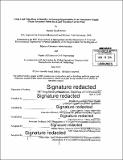| dc.contributor.advisor | Chris Caplice and Carolina Osorio. | en_US |
| dc.contributor.author | Bolton, Jennifer Sarah | en_US |
| dc.contributor.other | Leaders for Global Operations Program. | en_US |
| dc.date.accessioned | 2014-10-08T15:29:51Z | |
| dc.date.available | 2014-10-08T15:29:51Z | |
| dc.date.copyright | 2014 | en_US |
| dc.date.issued | 2014 | en_US |
| dc.identifier.uri | http://hdl.handle.net/1721.1/90798 | |
| dc.description | Thesis: M.B.A., Massachusetts Institute of Technology, Sloan School of Management, 2014. In conjunction with the Leaders for Global Operations Program at MIT. | en_US |
| dc.description | Thesis: S.M., Massachusetts Institute of Technology, Department of Civil and Environmental Engineering, 2014. In conjunction with the Leaders for Global Operations Program at MIT. | en_US |
| dc.description | Title as it appears in MIT commencement exercises program, June 6, 2014: Reducing automotive supply chain complexity through analysis of demand and lead time variation. Cataloged from PDF version of thesis. | en_US |
| dc.description | Includes bibliographical references (pages 87-89). | en_US |
| dc.description.abstract | Lead time information from suppliers influences decisions at every level of a supply chain, from sourcing and purchasing, to inventory policies, transportation, and plant design. Large volume, high complexity manufacturers, like those in the automotive industry, collect and store enormous amounts of data, but due to departmental boundaries, out-dated computing systems, and day-to-day priorities, they often do not analyze this valuable information. We analyze lead time data from Nissan on more than 13,000 SKUs and more than 400 suppliers, and apply the analysis to two supply chain and logistics problems: safety stock and transportation fleet sizing, identifying about $10MM of one-time and continuing savings opportunities. In both cases, we similarly are looking at creating a strategic buffer, either in terms of inventory or trailers, to account for variability in lead time. Much of the academic literature around lead time focuses on complex optimization algorithms, concepts far removed from the reality of Nissan's operations. We bridge the gaps between the rigor of academic analysis to practical application in the automotive industry. Our experiments with heuristic inventory policies to reduce space requirements, holding costs and expedited shipments, as well as our vehicle pooling simulation, should provide valuable transferable insights. Similarly, our experiences implementing these ideas and processes in a business environment and our observations on organizational structure should inform process change both in automotive and other industries. | en_US |
| dc.description.statementofresponsibility | by Jennifer Sarah Bolton. | en_US |
| dc.format.extent | 94 pages | en_US |
| dc.language.iso | eng | en_US |
| dc.publisher | Massachusetts Institute of Technology | en_US |
| dc.rights | M.I.T. theses are protected by copyright. They may be viewed from this source for any purpose, but reproduction or distribution in any format is prohibited without written permission. See provided URL for inquiries about permission. | en_US |
| dc.rights.uri | http://dspace.mit.edu/handle/1721.1/7582 | en_US |
| dc.subject | Sloan School of Management. | en_US |
| dc.subject | Civil and Environmental Engineering. | en_US |
| dc.subject | Leaders for Global Operations Program. | en_US |
| dc.title | Using lead time data to identify cost saving opportunities in an automotive supply chain : inventory safety stock and trucking carrier pool | en_US |
| dc.title.alternative | Reducing automotive supply chain complexity through analysis of demand and lead time variation | en_US |
| dc.type | Thesis | en_US |
| dc.description.degree | M.B.A. | en_US |
| dc.description.degree | S.M. | en_US |
| dc.contributor.department | Leaders for Global Operations Program at MIT | en_US |
| dc.contributor.department | Massachusetts Institute of Technology. Department of Civil and Environmental Engineering | |
| dc.contributor.department | Sloan School of Management | |
| dc.identifier.oclc | 891583202 | en_US |
